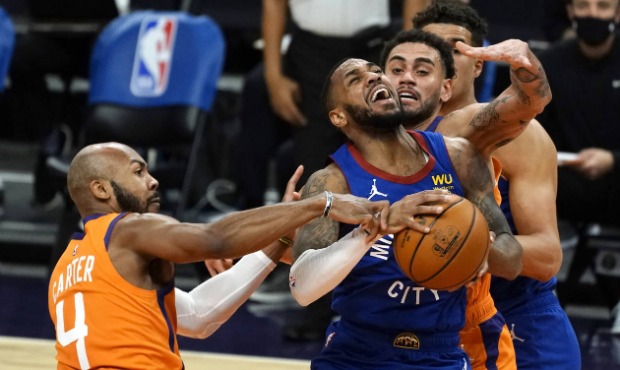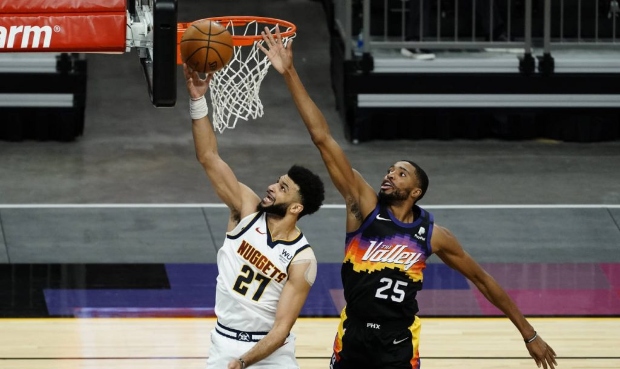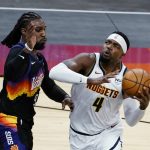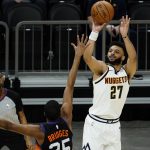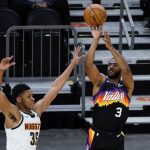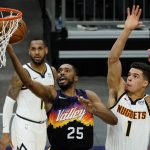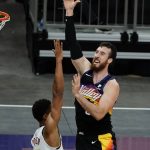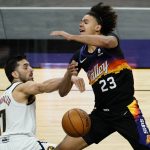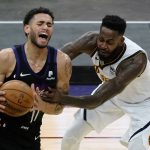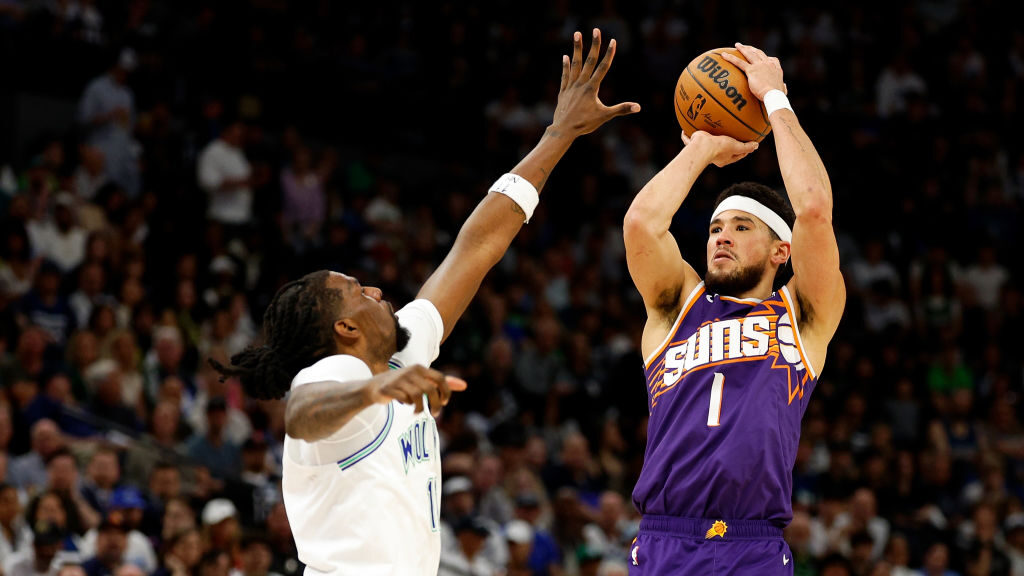Why the Suns’ recent losing skid shouldn’t set off alarms
Jan 26, 2021, 8:48 AM | Updated: 1:56 pm
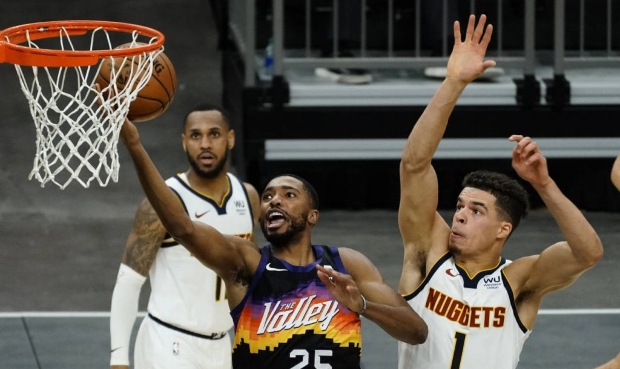
Phoenix Suns forward Mikal Bridges (25) drives past Denver Nuggets forward Michael Porter Jr. (1) during the second half of an NBA basketball game Saturday, Jan. 23, 2021, in Phoenix. (AP Photo/Rick Scuteri)
(AP Photo/Rick Scuteri)
While the expectations last year for the Phoenix Suns were much lower, they also fizzled after a hot start to the season.
So, with the Suns losing five of their last seven games this year, dropping them to 8-7, there is angst in the air.
Is it justified? I am not qualified to tell you how to feel. What I can tell you is of four areas where the Suns have either improved recently or will improve over the next couple weeks.
Here they are, starting with the most encouraging development for the franchise on the court in a few years.
Play of Deandre Ayton
I mean, where else would we start?
If you’re feeling frisky enough to go here, the big fella has flipped the switch. Over the course of Ayton’s 124 professional basketball games, we’ve seen blips on the radar of the dominant force he could be. Consistency has always remained at the top of the wish list.
Ayton took on perhaps his largest wave of criticism of his career before three games were postponed and after a dud against the Washington Wizards. In what has almost always been the case, he responded.
The 22-year-old has played the best four-game stretch of his career, and whatever other four games place second don’t come close.
Ayton is averaging 22.0 points, 14.8 rebounds, 2.0 blocks and 4.3 free throw attempts per game in his last four.
The culmination was Saturday’s double-overtime loss to the Denver Nuggets, when Ayton was as direct and decisive as we’ve ever seen him.
Ayton’s hesitation when catching the ball within five feet of the basket has always been a cause for concern. It was a visual representation of what the opposite of forcing it looks like.
A possession like this one below with Ayton pivoting away from the basket has been seen dozens of time by now, but instead of Ayton using it to move away from the basket, he used it as a fake.
Even his turnovers were highlights. The Suns will take traveling calls like this every day of the week if Ayton keeps staying aggressive. Watch how much ground he covers:
How fluid he makes that look is part of what made him such a tantalizing prospect. Unlocking his dribbling is how he becomes a 20-25 points-per-game scorer and that’s not because he isn’t well equipped. It’s all mentality.
Confidence will make Ayton dangerous, especially on the defensive end, where he can limit MVP candidates.
I’ve watched Nikola Jokic play a lot of basketball, and I’ve never seen him be so off on touch shots like he was Saturday. Ayton was clearly affecting his play and had Jokic’s timing down.
Ayton’s so good at containing on the ball.
Observe here how Jokic’s shoulder fake moves Ayton — but just barely — and then Ayton contests wonderfully.
Check out the double contest here with his ridiculous length:
Ayton was the primary reason the Suns won Wednesday in Houston, and if Jamal Murray’s game-tying heave on Saturday that Ayton defended expertly would have been correctly called a travel, he would have been the deciding factor of another victory.
There were reasons to doubt if Ayton could even be the Suns’ third-best player this season, but if they get this guy the rest of the year, he’ll have a case against Chris Paul or Devin Booker for top-two. Time will tell, but if the Suns can get that guy 6-8 games out of 10, instead of 1-3, they are a vastly different team.
We are already seeing what that looks like with Mikal Bridges. Ayton is next.
Crunch-time growing pains
The Suns entered play Monday 11th in offensive rating and tied for 10th in defensive rating.
They are an objectively good team and the only real problem they have right now is finishing games.
The Suns’ net rating plummets to -8.2 in the fourth quarter, ranking 26th in the league. Looking more specifically at crunch-time minutes, NBA.com has Phoenix down for 55, the third-most. The Suns are minus-28 in those minutes, the second-worst plus/minus of all 30 teams.
While it’s obvious watching that some of this is due to a lack of cohesion, they also aren’t hitting shots. A hat tip to Suns Twitter’s Cody Hunt spotting a drop in three-point shooting:
Suns team 3P% and attempts by quarter so far this year:
Q1- 39.3% (9.7 3PA/G)
Q2- 36.6% (9.7)
Q3- 40.3% (10.3)
Q4- 26.2% (8.4)— Cody Hunt (@co_dhunt) January 25, 2021
That 26.2% is 29th leaguewide.
So who exactly is dragging the number down? It’s some of the bigger names.
Cam Johnson is 8-of-26 (30.8%), Booker is 4-for-19 (21.1%), Jae Crowder is 3-for-16 (18.8%) and Paul is 2-of-10 (20.0%).
That’s some pretty crummy variance. Head coach Monty Williams after a few losses has noted the Suns simply didn’t convert on some good looks down the stretch, and that matches up with those poor percentages.
Tack on a few makes for each player to put them more toward their season averages and you’ve also got a few more wins for the Suns.
It isn’t the clear-cut top reason for the fourth-quarter woes but certainly isn’t helping, and there’s some progression to the mean coming.
Also, the Point God is gonna figure some things out. More on that in a bit.
Depth reality check
A lot was made of the Suns’ depth after a strong offseason for general manager James Jones. Those positive reviews weren’t necessarily wrong but might have set the expectations too high.
With the starting five plus Crowder, Cam Payne and Dario Saric, the Suns have a rock-solid group that goes eight-deep. That’s thanks to the terrific play of Payne to open the year, which we’ll get to here in a minute.
Beyond that, the Suns have capable NBA players. That’s a drastic improvement compared to the last few years, like having a reliable rotation. But to expect anything consistent from the team’s ninth-12th men — or generally taking much stock in their involvement — is a luxury few teams are afforded.
There was a mild uproar on Saturday when wing Abdel Nader played 30 minutes, earning the perimeter spot alongside Paul through two overtimes Saturday with Booker sidelined. When Cam Johnson’s cramps were too much in the first overtime, Nader got the nod.
There’s not a good answer in terms of who should have been out there.
Jevon Carter is the best defender but his point-guard frame makes it spotty in terms of matchups in crunch time. Denver had Jamal Murray, Gary Harris, Monte Morris, Michael Porter Jr. and Jokic in. That’s a difficult ask given who the Suns would want Paul on already.
Langston Galloway was thrown out there for a few minutes in the fourth quarter to offer his high-level shooting as an offensive boost when Denver played P.J. Dozier and other depth pieces, but again, his defensive shortcomings are problematic.
E’Twaun Moore hasn’t played all season after a rough go in the preseason, and beyond that, isn’t an answer for the same reasons as Galloway.
Nader provides the most ideal size and athleticism on the wing of the group and it was useful on Porter when the Suns were shorthanded.
Payne would have been out there most nights, but Denver’s personnel plus the backup point guard not being the same since his ankle injury were good reasons for him to sit.
During the Suns’ hiatus with three games postponed, Payne was given more time to recover from a right ankle sprain that had him miss two games before the stoppage.
In four outings since returning, Payne has lost the mojo that made him the key ingredient to the Suns’ early-season success.
Pre-injury Payne (9 games) – 17.8 MPG, 7.7 PPG, 2.4 RPG, 4.3 APG, 1.3 TPG, 50.0 FG%, 42.9 3P%, 100.0 FT%
Post-injury Payne (4 games) – 16.8 MPG, 4.3 PPG, 1.5 RPG, 3.0 APG, 1.0 TPG, 31.3 FG%, 25.0 3P%, 100.0 FT%
Payne is plus-59 in 227 minutes this year. That’s second on the team. Right behind him is Dario Saric at plus-55 in just 132 minutes.
Saric has been out since the postponements due to health and safety protocols, first popping up on the injury report with Damian Jones on Jan. 17.
The return of rookie Jalen Smith at least offers an alternative to Frank Kaminsky if the opposition allows for Smith to play out of position, as he appears to be a 4 for the Suns at this stage due to his nimble physique. But even then, now we’re back to analyzing the group beyond the core eight and the limitations each option presents.
With the Suns having three days between Saturday’s defeat and Wednesday’s return against the Oklahoma City Thunder, perhaps that’s what Payne needs to get back to his old ways. The return of Saric will only help as well, as an ETA on that remains unclear.
The supporting pieces near the end of the bench are simply much better in spurts, from 8-15 minutes a game. Once that number gets north of 15, those guys really need to have it going in order to not start to trail off. We saw that with Kaminsky last season and will with the others until the group is back near 100%.
It’s less about who Williams is playing and more of an unavoidable problem.
Like almost any team in the league, once the Suns get down more than one important piece, their depth evaporates. It’s an every-season issue and the Suns have enough high-end talent to quell any concern.
Chris Paul’s assimilation
Paul has been here before early in the season, as Suns Twitter’s Chris Coffel notes in a nice find:
Don’t know the clutch numbers but a quick glance at OKC from last year shows they started 5-10 with losses by 5, 4, 3, 2, 2, 5, and 3. Perhaps some similar issues before CP3 got it going?
— Chris Coffel (@Chris_Coffel) January 23, 2021
Eight of those 10 losses for the Thunder were in close games involving crunch-time minutes. The plus-minus for those minutes was zero.
Something to take into account is that was Paul’s team from the jump, an easier transition as opposed to meshing with Booker and Ayton. Considering how incredible he was in the clutch for the Thunder last season, that’s surprising.
Here’s Paul through 15 games the past two seasons:
2019-20 Paul – 15.9 PPG, 4.1 RPG, 5.7 APG, 2.1 TPG, 1.9 SPG, 44.7 FG%, 40.3 3P%, 87.5 FT%
2020-21 Paul – 13.8 PPG, 4.7 RPG, 9.0 APG, 2.3 TPG, 0.9 SPG, 43.6 FG%, 27.7 3P%, 97.4 FT%
The Thunder finished out the year 39-18. Paul’s numbers in the 55 of those games he played were expectedly awesome:
Rest-of-year Paul in 2019-20 – 18.1 PPG, 5.2 RPG, 7.0 APG, 2.3 TPG, 1.5 SPG, 49.9 FG%, 35.5 3P%, 92.0 FT%
In those 57 games, the Thunder were a staggering plus-103 in clutch minutes. That was far and away the best number in the NBA, with the next two closest teams checking in at plus-67 and plus-48.
Will we see that much of a spike for the Suns? Maybe not to that extent, but with the way Paul and Booker have played to start the year, they’re going to be better.
Whichever one gets there first will benefit the other, and it should be smooth sailing from there. That will greatly lift the clutch numbers, which both have shown they can positively impact.
To end it on simple terms, if you were told in November the Suns’ biggest problem through 15 games would be crunch time and the individual performance of Paul and Booker, you wouldn’t be all that worried, right?


